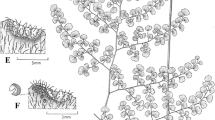Abstract
The aim of this work was to collect new information about pollen morphology and pollen wall structure comparing Cupressus species from the Old World and New World. Cupressus is a nonmonophyletic genus that includes species that appear to be divided into Old World and New World clades. Observations in this study on cypress pollen indicate that grain size and composition of intine β-glucans are different between the considered Old World and New World species. Different from all the other American cypress species, pollen of C. macrocarpa reacted to dying in a similar manner to Old World species. Rehydrated pollen grains collected from 20 Asian, Afro-Mediterranean and American cypress species were measured under a light microscope. The size of the pollen grains and the percentage of intine in relation to the pollen grain diameter were significantly different between Old World and New World species. Pollen wall composition was tested after addition of different dyes to the hydration solution, and subsequent observations were carried out by light and fluorescence microscopy. Lugol and calcofluor staining showed differences in composition of the middle and inner intine layers between New World and Old World species.







Similar content being viewed by others
References
Accorsi CA, Bandini Mazzarri M, Dallai D (1989) Flora Palinologica Italiana. Sezione Aeropalinologica – S 103 Cupressus sempervirens L. Aerobiologia 5:161–168
Baig NM, Tranquillini W (1976) Studies on upper timberline: morphology and anatomy of Norway spruce (Picea abies) and stone pine (Pinus cembra) needles from various habitat conditions. Can J Bot 54:1622–1632
Benninghof WS, Edmonds RL (1972) Ecological system approaches to aerobiology. Identification of component elements and their functional relationships. International Biological Program. Aerobiology Program. US/IBP Aerobiology Program Handbook N. 2, Michigan University, Ann Arbor
Bortenschlager S (1990) Aspects of pollen morphology in the Cupressaceae. Grana 29:129–137
Calamassi R (1986) Caractérisation de quelques provenances de Pinus halepensis Mill. sur la base de la structure anatomique et morphologique des aiguilles. Ann For Sci 43:281–298
Calamassi R, Pugliesi SR, Vendramin GG (1988) Genetic variation in morphological and anatomical needle characteristics in Pinus brutia Ten. Silvae Genet 37:199–206
Calamassi R, Della Rocca G, Falusi M, Paoletti E, Strati S (2001a) Resistance to water stress in seedlings of eight provenances of Pinus halepensis Mill. Ann For Sci 58:663–672
Calamassi R, Paoletti E, Strati S (2001b) Frost hardening and resistance in three Aleppo pine (Pinus halepensis Mill.) provenances. Isr J Plant Sci 49:179–186
Chicchiricò G, Pacini E (2007) Cupressus arizonica pollen wall zonation and in vitro hydration. Plant Syst Evol 270:231–242
Chicchiricò G, Spanò L, Torraca G, Tartini A (2009) Hydration, sporoderm breaking and germination of Cupressus arizonica pollen. Plant Biol 11:359–368
Di Fernando DD, Lazzaro MD, Owens JN (2005) Growth and development of conifer pollen tubes. Sex Plant Reprod 18:149–162
Duhoux E (1982) Mechanism of exine rupture in hydrated taxoid type of pollen. Grana 21:1–7
Erdtman G (1957) Pollen and spore morphology. Plant taxonomy. Gymnospermae, Pteridophyta, Bryophyta. Almquist & Wiksell, Stockholm
Farjon A (2005) A monograph of Cupressaceae and Sciadopitys. Kew Royal Botanic Garden, UK
Gadek AP, Alpers DL, Heslewood MM, Quinn CJ (2000) Relationships within Cupressaceae sensu lato: a combined morphological and molecular approach. Am J Bot 87:1044–1057
Galán C, Fuillerat MJ, Comtois P, Dominguez-Vilches E (1998) Bioclimatic factors affecting daily Cupressaceae flowering in southwest Spain. Int J Biometeorol 41:95–100
Grilli Caiola M, Travaglini A, Giuliano M (2000) Palynological study of Cupressus sempervirens L. var. pyramidalis and var. horizontalis. Plant Biosyst 134:99–109
Heslop-Harrison J, Heslop-Harrison Y (1985) Germination of stress tolerant Eucalyptus pollen. J Cell Sci 86:1–8
Heslop-Harrison J, Heslop-Harrison Y (1991) Structural and functional variation in pollen intines. In: Blackmore S, Barnes SH (eds) Pollen and spores. Patterns of diversification. The Systematics Association Special Volume no. 44. Clarendon Press, Oxford, pp 331–343
Hidalgo PJ, Galán C, Dominguez E (1999) Pollen production of the genus Cupressus. Grana 38(5):296–300
Hughes J, McCully ME (1975) The use of an optical brightener in the study of plant structure. Stain Tech 50:319–329
Jensen WA (1962) Botanical histochemistry. WH Freeman, San Francisco
Joahansen DA (1940) Plant microtechnique. McGraw-Hill, New York
Kurmann MH (1994) Pollen morphology and ultrastructure in the Cupressaceae. Acta Bot Gallica 141:141–147
Little D (2006) Evolution and circumscription of the true cypresses (Cupressaceae: Cupressus). Syst Bot 31:461–480
Little D, Schwarzbach AE, Adams RP, Hsieh CF (2004) The circumscription and phylogenetic relationships of Callitropsis and the newly described genus Xanthocyparis (Cupressaceae). Am J Bot 91:1871–1880
Mergen F (1958) Genetic variation in needle characteristics of slash pine and in some of his hybrids. Silvae Genet 7:31–38
Mergen F (1963) Ecotypic variation in Pinus strobus. Ecology 44:716–727
Milanesi C, Cresti M (1997) Pollen morphology and ultrastructure in Cupressus sempervirens. Atti Accad Fisiocrit Siena XV:59–61
O’Brien TP, McCully ME (1981) The study of plant structure principles and selected methods. Thermacarphy, Melbourne
Pacini E, Franchi G, Ripaccioli M (1999) Ripe pollen structure and histochemistry of some gymnosperms. Plant Syst Evol 217:81–99
Pichot C, El Maâtaoui M (2000) Unreduced diploid nuclei in Cupressus dupreziana A. Camus pollen. Theor Appl Genet 101:574–579
Raddi P, Moricca S, Andreoli C (2000) Cypress pollen: botanic aspects in fourteen cypress species and prospects for research. Allerg Immunol 32(3):125–127
Walter H, Lieth H (1960) Klimadiagramm Weltatlas. VEB Gustav Fisher Verlag, Jena
Wolf CB, Wagener WE (eds) (1948) The new world Cypresses, vol 1. El Aliso, California
Yatomi R, Nakamura S, Nakamura N (2002) Immunochemical and cytochemical detection of wall components of germinated pollen of gymnosperms. Grana 41(1):21–28
Author information
Authors and Affiliations
Corresponding author
Rights and permissions
About this article
Cite this article
Danti, R., Della Rocca, G., Mori, B. et al. Old World and New World Cupressus pollen: morphological and cytological remarks. Plant Syst Evol 287, 167–177 (2010). https://doi.org/10.1007/s00606-010-0309-y
Received:
Accepted:
Published:
Issue Date:
DOI: https://doi.org/10.1007/s00606-010-0309-y




